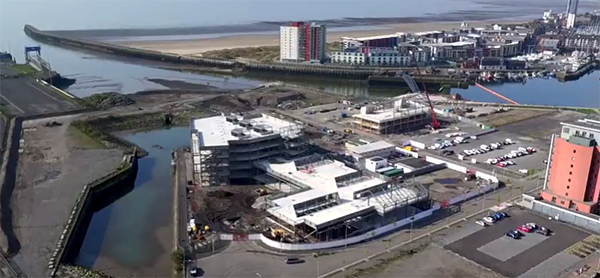Let’s begin by setting out my stall: Housing in Wales is dysfunctional, inefficient, corrupt, wasteful of public funding, damaging to Welsh community life, and undermines Welsh nationhood.
It’s a great system . . . but not for the Welsh.
∼
LE ROI SOLEIL
In an earlier post (scroll down to the section ‘Who will buy . . . ‘), we met Dr Glen Peters. An interesting character, Glen.
Before moving to Wales he was a senior partner in PwC, one of the ‘Big Four’ accounting firms, those pillars of the City of London that give glowing reports of financial health to firms about to head up Shit Creek and when they’re not doing that they’re extolling the probity of corrupt third world regimes.
The ‘Big Four’ will do and say anything for money. Making Peters a man with an interesting past.

He seems to have arrived in Wales in 2010 and in December of that year he founded Western Solar Ltd.
He also launched himself as the beneficent and culture-loving squire with Menter Rhosygilwen, a charity (No 1139848) which, to judge by its programme, at least recognises it is in Wales. Rhosygilwen being the name of his mansion not far from Cilgerran in north Pembrokeshire; with performances taking place in Neuadd y Dderwen, which looks like a set for Game of Thrones. Neuadd y Dderwen must have cost a few bob.
Being a man who understands money it didn’t take Glen long to realise how easy it is to screw grants out of the self-styled ‘Welsh Government’. For it came to pass that he received £141,000 to turn an old cowshed into a small factory turning out units for eco-friendly homes.
Six such properties were built in the off-the-beaten-track hamlet of Glanrhyd, a development called Pentre Solar. We are told that these were built specifically for the Ateb group (formerly Pembrokeshire Housing) who took all six of them for £900,000. Money it had been loaned by the aforementioned and self-styled ‘Welsh Government’.
But given that there is no worthwhile oversight or monitoring of ‘loans’ it’s unlikely this money will ever be repaid. As far as the ‘Welsh Government’ is concerned, once the money is gone, and the boxes are ticked, that’s the end of it.
Though there are a number of curious features about this deal.
Let’s start with the fact that in a number of places it’s claimed that these eco homes were built for half the price of traditional brick-built homes. For example, in this video, at 0:32, by Peters himself. Yet Ateb paid £900,000 for six properties, £150,000 per home.
To build a traditional 2/3-bedroom, semi-detached house in north Pembrokeshire would cost £90,000 – 120,000. Which means that if Glen Peters is right, and he could build his houses for half that, then he made a very tidy profit when Ateb paid him £150,000 per house.
Something else that troubles me is that housing associations like Ateb already receive millions of pounds every year from various funding streams, so why was it necessary to bung them another £900,000? Because I’m damn sure the Tŷ Solar properties were not bought to meet a pressing local demand out in the middle of nowhere.
Question 1: Can Ateb guarantee that the houses at Glanrhyd, paid for with Welsh public funding, were allocated to Welsh people?
Whatever the answers, a lot of moolah has already gone west and there’s more on the way. Next up is a 15-home ‘garden village’ for Boncath. Why Boncath? Well it might be because that’s where Victoria Beard lives. ‘Who’s she, Jac?’ you demand.
Well, she appeared on the website a few months back (before I wrote my earlier piece), as one of the locals connected with, or employed by, Menter Rhosygilwen. Though I’m told she was actually employed by Pembrokeshire county council before branching out on her own with Foresight She Ltd, yet another ‘consultancy’ that seems to have gone the way of all flesh.
◊
BURRY PORT
Also mentioned in the piece I linked to regarding Boncath is “a 30-unit scheme of affordable homes already lined up for a site in Carmarthenshire on behalf of Carmarthenshire County Council”. To be specific, this development is in Burry Port, to the west of Llanelli.
For some reason Burry Port has been targeted for excessive development in recent years with hundreds of new houses built, almost all of which have been bought by English buyers, mainly retirees or those close to retirement. Yet more housing is planned – and Plaid Cymru welcomes it!
Councillor Alun Lenny is quoted as saying, “There’s 103 first-step homes here, affordable homes, all low cost homes”. Yet the WalesOnline report in which he’s quoted tells us: “There will be eight different house types on the new development, mainly two and three-bedroom homes, as well as some with four bedrooms, with the majority semi-detached.” And goes on to say: “21 of the 103 homes will be offered as affordable housing for sale or rent”.
Four-bedroom houses are not “first-step homes”.
Plaid Cymru really hasn’t got a clue. They don’t even understand what they’re giving planning permission for. No wonder Wales is in the mess it is. Though it would have been nice if the report had told us who plans to build these houses, and how much public funding is involved.

Question 2: For Plaid Cymru. Can you offer any promises that these “affordable homes” will be bought by local people and can you guarantee that the properties in the social housing “ghetto” (mentioned in the report) will be allocated to local people?
The development with which Glen Peters is involved in Burry Port, the “divided town which didn’t want any more new homes”, is for 32 homes to be built by Cartrefi Croeso Cyf., which we looked at in the previous post. Let’s remind ourselves what we read there.
The managing director of Cartrefi Croeso is Robin Staines, and the sole directors are Jacob Morgan and Sarah Wendy Walters, also employees of Carmarthenshire county council. Which effectively means that this company belongs to Mark Vincent James, the Cardiff Bay property magnate who doubles up as CEO of Cyngor Sir Gâr.
But why would a council with its own housing department need Cartrefi Croeso? I suppose an obvious answer might be that the county can no longer build new council housing. But then, there are any number of housing associations operating in the county – shouldn’t they be filling the gap? The obvious answer to that is, yes they should. And to all intents and purposes they are.
But Mark James doesn’t control those housing associations.
◊
‘STICK ON A FEW SOLAR PANELS – BINGO!’
Even so, let’s not be too hard on Jamesie Boy, because he’s received great encouragement from (the aforementioned and self-styled) ‘Welsh Government’; that shower is providing the funding for what appear to be the retirement properties Cartrefi Croeso plans to build.
Specifically, the funding comes from the Innovative Housing Programme, launched in February 2017. In its first year the IHP was restricted to Registered Social Landlords and councils, but in its second year – beginning April 2018 – it was open to private companies, which explains the involvement of Cartrefi Croeso. For although it’s owned by the council it is a private company and registered as such with Companies House.
Though it seems to have given itself a wide remit, as shown in the panel below, taken from the Companies House entry. The first two categories, 41100 and 41202, obviously cover the Burry Port development, but the other two suggest it might be worth keeping an eye on Cartrefi Croeso.

Over three years the Innovative Housing Programme budget will shell out £90m.
We’ve come a long way from the £141,000 given to Glen Peters to convert the old cowshed. We’ve considered a lot of Welsh public funding, and you have to ask how much benefit Welsh people and Welsh communities will derive from this expenditure. As I mentioned earlier, the properties being built by Mark James Cartrefi Croeso in Burry Port are almost certainly retirement properties.
Given the excessive housebuilding the town has seen in recent years, and the buyers’ profile, I can’t help wondering if someone, somewhere, has designated Burry Port a retirement settlement. Perhaps the locals should be informed?
Question 3: For Lesley Griffiths. Why is your self-styled ‘Welsh Government’ giving public funding to private companies to build new homes – for which there may be no local demand – when you already fund countless housing associations and there is already a private sector building open market dwellings?
Almost inevitably, there are hidden costs to the Welsh public purse, for in this article from last week’s Tivyside Advertiser Glen Peters tells us that to build his houses, “Welsh tree trunks will arrive at one end and houses will emerge from the other” . . . which will mean paying ‘re-wilders’ and the like to plant more trees.

As I said earlier, it’s a great system . . . but not for us.
◊
LABYRINTHINE, CORRUPT, COLONIALIST
Looking at the wider picture, housing in Wales is an absolute shambles. I could write a book about it, but it would be too depressing, it would drive me to drink. One example, again from the Wild West, might serve to explain what I mean.
Ateb has a subsidiary named Mill Bay Homes. I’ve written about Mill Bay Homes more than once, and had threats from solicitors for suggesting that everything was not above board. Just type ‘Mill Bay Homes’ into the Search box at the top of the sidebar.
Since then, Mill Bay Homes has gone entirely private, is no longer a Registered Social Landlord, and yet is still somehow part of the Ateb group. But despite being a free-flying bird MBH still owes the parent company £5.5m, secured with a floating charge over everything MBH has.
Much of this five-and-a-half million pounds – and the debt was larger at one time – is public funding given to Ateb, then transferred to Mill Bay Homes for it to build nice properties in Pembrokeshire for investors, retirees, and those seeking a holiday home.
How about that – holiday homes funded from the Welsh public purse!
Even if you’ve never heard of Walter Scott’s Marmion I bet you’ll be familiar with “O, what a tangled web we weave when first we practise to deceive”. Though I’m not for one minute suggesting that it’s apposite to the relationship between the self-styled ‘Welsh Government’, the Ateb group and Mill Bay Homes.
To explain how convoluted and confusing it can all get when publicly-funded bodies spawn private companies let us hie to Cilgerran, just a short distance from Glen Peter’s sumptuous pad.
There we find properties being built by Mill Bay Homes. Here’s one for sale with John Francis and it offers ‘Shared Ownership’ (actually a shared lease). Ateb, the Registered Social Landlord, is allowed to offer Shared Ownership, but Mill Bay Homes, the private company, is not.
Question 4: I throw this one out for anyone. Seeing as private company, non-RSL, Mill Bay Homes should not be offering buyers ‘Shared Ownership’ why is it allowed to do so?
Maybe I’m wasting my time, for as I say, there is no effective monitoring or oversight of housing associations.
It’s a jungle that gets more impenetrable every year. But that’s how housing associations like it. That’s how the ‘Welsh Government’ likes it. And it’s certainly how those who control devolution in Wales like it. You and I are not supposed to understand . . . or question.
◊
But sod it, because I’m going to end with some questions for the self-styled ‘Welsh Government’:
- Why do you allow the building of so many houses Wales doesn’t need, at prices most Welsh people can’t afford, and often in places where these properties are not needed?
- Given the way housing associations operate tens of million of pounds every year is spent housing people with no Welsh connections, so how difficult would it be to insist on a five-year residency qualification for social housing, and then divert the money saved to the NHS and education?
- Why do you not ban publicly-funded bodies from setting up private subsidiaries that often receive indirect public funding and yet over which you have even less influence than the parent?
- If you’re serious about encouraging the private sector why threaten it with these private subsidiaries that also have the unfair advantage of insider knowledge?
- Will you examine the relationship between Ateb and Mill Bay Homes and all similar publicly-funded bodies with private subsidiaries?
- Can you offer a definition of ‘affordable housing’?
- Thinking of Burry Port, do you ever consult local people over plans for their community – real locals?
- Explain how it is in the interests of Wales to attract an elderly population from outside of Wales?
- Will you revisit the £900,000 given to Ateb to purchase six properties from Western Solar Ltd that – if the builder is correct – cost less than half of that sum to build?
- Why do we have so many housing associations competing with each other, duplicating each other’s role, and all in receipt of public funding? How much do you estimate could be saved from mergers, simply on chief executives’ salaries?
- What do you intend doing to help those in the south east currently being outbid in the local property market by commuters from Bristol?
- Why don’t you relieve local authorities of the hassle by imposing a national 200% council tax on all second homes? And close the loophole.
- Can you guarantee that there are no properties sold as holiday homes that were built with public funding, or bought using one of the many schemes you offer to help people buy a home?
- Even though you’ve had twenty years, why have you found it impossible to develop a housing sector attuned to and serving the needs of Welsh people?
♦ end ♦
































